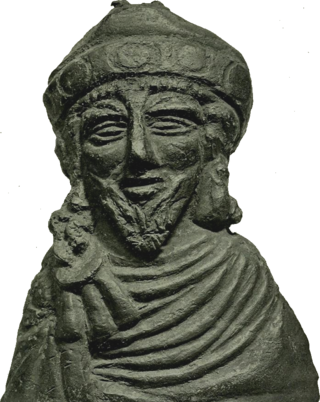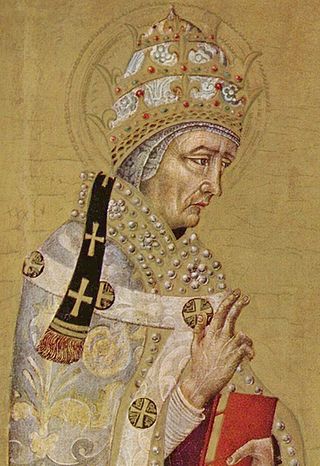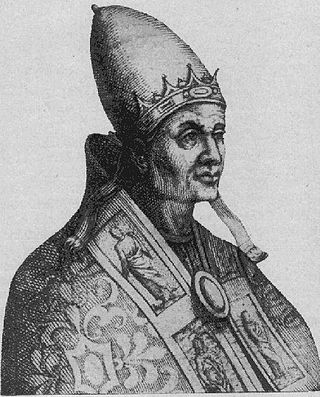Pope Agapetus I was the bishop of Rome from 13 May 535 to his death. His father, Gordianus, was a priest in Rome and he may have been related to two popes, Felix III and Gregory I.
Pope Boniface IV, OSB was the bishop of Rome from 608 to his death. Boniface had served as a deacon under Pope Gregory I, and like his mentor, he ran the Lateran Palace as a monastery. As pope, he encouraged monasticism. With imperial permission, he converted the Pantheon into a church. In 610, he conferred with Bishop Mellitus of London regarding the needs of the English Church. He is venerated as a saint in the Catholic Church with a universal feast day on 8 May.
Pope Gregory II was the bishop of Rome from 19 May 715 to his death. His defiance of Emperor Leo III the Isaurian as a result of the iconoclastic controversy in the Eastern Empire prepared the way for a long series of revolts, schisms, and civil wars that eventually led to the establishment of the temporal power of the popes.

Pope Gregory III was the bishop of Rome from 11 February 731 to his death. His pontificate, like that of his predecessor, was disturbed by Byzantine iconoclasm and the advance of the Lombards, in which he invoked the intervention of Charles Martel, although ultimately in vain. He was the last Pope to seek the consent of the Byzantine exarch of Ravenna for his election, and of Syrian origin, the last non-European pope until the election of Pope Francis more than 1,271 years later in 2013.

Pope Zachary was the bishop of Rome from 28 November 741 to his death. He was the last pope of the Byzantine Papacy. Zachary built the original church of Santa Maria sopra Minerva, forbade the traffic of slaves in Rome, negotiated peace with the Lombards, and sanctioned Pepin the Short's usurpation of the Frankish throne from Childeric III. Zachary is regarded as a capable administrator and a skillful and subtle diplomat in a dangerous time.

Pope Innocent III, born Lotario dei Conti di Segni, was the head of the Catholic Church and ruler of the Papal States from 8 January 1198 until his death on 16 July 1216.
Pope Formosus was the bishop of Rome and ruler of the Papal States from 6 October 891 until his death on 4 April 896. His reign as pope was troubled, marked by interventions in power struggles over the Patriarchate of Constantinople, the Kingdom of West Francia, and the Holy Roman Empire. Because he sided with Arnulf of Carinthia against Lambert of Spoleto, Formosus's remains were exhumed and put on trial in the Cadaver Synod. Several of his immediate successors were primarily preoccupied by the controversial legacy of his pontificate.

Year 607 (DCVII) was a common year starting on Sunday of the Julian calendar. The denomination 607 for this year has been used since the early medieval period, when the Anno Domini calendar era became the prevalent method in Europe for naming years.

Phocas was Byzantine emperor from 602 to 610. Initially, a middle-ranking officer in the Eastern Roman army, Phocas rose to prominence as a spokesman for dissatisfied soldiers in their disputes with the court of the Emperor Maurice. When the army revolted in 602, Phocas emerged as the natural leader of the mutiny. The revolt proved to be successful and led to the capture of Constantinople and the overthrow of Maurice on 23 November 602 with Phocas declaring himself emperor on the same day.
Pope Vigilius was the bishop of Rome from 29 March 537 to his death. He is considered the first pope of the Byzantine papacy. Born into Roman aristocracy, Vigilius served as a deacon and papal apocrisiarius in Constantinople. He allied with Empress Theodora, who sought his help to establish Monophysitism, and was made pope after the deposition of Silverius. After he refused to sign Emperor Justinian I's edict condemning the Three Chapters, Vigilius was arrested in 545 and taken to Constantinople. He died in Sicily while returning to Rome.
Pope Damasus II was the Bishop of Rome and ruler of the Papal States from 17 July 1048 to his death on 9 August that same year. He was the second of the German pontiffs nominated by Emperor Henry III. A native of Bavaria, he was the third German to become pope and had one of the shortest papal reigns.
Pope Constantine was the bishop of Rome from 25 March 708 to his death. One of the last popes of the Byzantine Papacy, the defining moment of his pontificate was his 710/711 visit to Constantinople, where he compromised with Justinian II on the Trullan canons of the Quinisext Council. The city's next papal visit occurred in 1967.
Pope Vitalian was the bishop of Rome from 30 July 657 to his death. His pontificate was marked by the dispute between the papacy and the imperial government in Constantinople over Monothelitism, which Rome condemned. Vitalian tried to resolve the dispute and had a conciliatory relationship with Emperor Constans II, who visited him in Rome and gave him gifts. Vitalian's pontificate also saw the secession of the Archbishopric of Ravenna from the papal authority.

Papal appointment was a medieval method of selecting the Pope. Popes have always been selected by a council of Church fathers, however, Papal selection before 1059 was often characterized by confirmation or nomination by secular European rulers or by the preceding pope. The later procedures of the Papal conclave are in large part designed to prohibit interference of secular rulers, which to some extent characterized the first millennium of the Roman Catholic Church, e. g. in practices such as the creation of crown-cardinals and the claimed but invalid jus exclusivae. Appointment may have taken several forms, with a variety of roles for the laity and civic leaders, Byzantine and Germanic emperors, and noble Roman families. The role of the election vis-a-vis the general population and the clergy was prone to vary considerably, with a nomination carrying weight that ranged from nearly determinative to merely suggestive, or as ratification of a concluded election.

The selection of the Pope, the Bishop of Rome and Supreme Pontiff of the Catholic Church, prior to the promulgation of In Nomine Domini in AD 1059 varied throughout history. Popes were often putatively appointed by their predecessors or by political rulers. While some kind of election often characterized the procedure, an election that included meaningful participation of the laity was rare, especially as the Popes' claims to temporal power solidified into the Papal States. The practice of Papal appointment during this period would later result in the putative jus exclusivae, i.e., the claimed but invalid right to veto the selection that Catholic monarchs exercised into the twentieth century.
The historical roots of Papal primacy can be traced back to the early centuries of Christianity, wherein the bishop of Rome, commonly referred to as the Pope, gradually accrued increasing authority and recognition. A confluence of historical, theological, and political factors contributed to this development.

The Byzantine Papacy was a period of Byzantine domination of the Roman Papacy from 537 to 752, when popes required the approval of the Byzantine Emperor for episcopal consecration, and many popes were chosen from the apocrisiarii or the inhabitants of Byzantine-ruled Greece, Syria, or Sicily. Justinian I reconquered the Italian peninsula in the Gothic War (535–554) and appointed the next three popes, a practice that would be continued by his successors and later be delegated to the Exarchate of Ravenna.

The Ostrogothic Papacy was a period from 493 to 537 where the papacy was strongly influenced by the Ostrogothic Kingdom, if the pope was not outright appointed by the Ostrogothic King. The selection and administration of popes during this period was strongly influenced by Theodoric the Great and his successors Athalaric and Theodahad. This period terminated with Justinian I's (re)conquest of Rome during the Gothic War (535–554), inaugurating the Byzantine Papacy (537–752).

The Tusculan Papacy was a period of papal history from 1012 to 1048 where three successive relatives of the counts of Tusculum were installed as pope.
The 600s decade ran from January 1, 600, to December 31, 609.










